The great art historian Erwin Panofsky (Hanover, 1892 - Princeton, 1968) has been considered, and continues to be considered, a continuator of the work of Aby Warburg, who in turn is considered an anticipator of Panofsky. All this is true to a certain extent, but it is equally true that, as Salvatore Settis pointed out in a recent essay devoted to Warburg, Panofsky and Warburg were both original, innovative scholars, endowed with a strong personality, who can (and should) be evaluated independently of each other: this is what we have also tried to do in this our little history of art criticism. We can start, of course, from a common basis, inaugurated by Warburg and also shared by Panofsky, which we can (trivializing) summarize in two key points: the critique of formalist criticism and Wölfflin’s theories, and the consideration that a work of art contains elements that refer to the cultural substratum of a society.
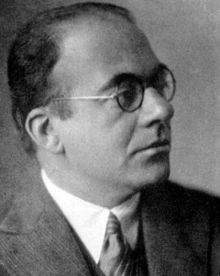 |
| Erwin Panofsky |
The different approach of the two scholars manifests itself, for example, in their interpretation of a drawing by Albrecht Dürer, the Death of Orpheus, taken from an engraving by an anonymous Ferrara artist, and itself derived perhaps from a lost Mantegna original. For Wölfflin, the work “is not simply copied, but is translated, form after form, into Schongauer’s language of modeling lines, and this is no small achievement. The drawing still appears harsh, the outlines break into sharp angles, the branches lack volume, but the care in execution makes manifest Dürer’s delight in imitation at a time when the artist felt the sculptural qualities of the original.” Panofsky’s reading, which relates Dürer’s drawing to the Death of Orpheus, which Andrea Mantegna painted on the ceiling of the Bridal Chamber in Mantua, is of a totally opposite sign: “Dürer’s interpretation may be even more classical than his direct Italian sources. In the drawing of the Orpheus the maenads are modeled beneath their robes with more perfection than appears in the Italian engraving, and the modern lute is carefully replaced by a more orthodox lyre.” If, therefore, for Wölfflin, who focuses on style (the scholar in fact speaks of lines, of drawing, of contours) the Death of Orpheus would be proof of Dürer’s belonging to a very specific area, the Germanic one, for Panofsky, who also evaluates the content of the work (the lyre replacing the lute), the artist’s personal inclination would have led him to transcend the boundaries of his own geographical area and even come closer to the classical source than Italian artists imbued with classical culture did.
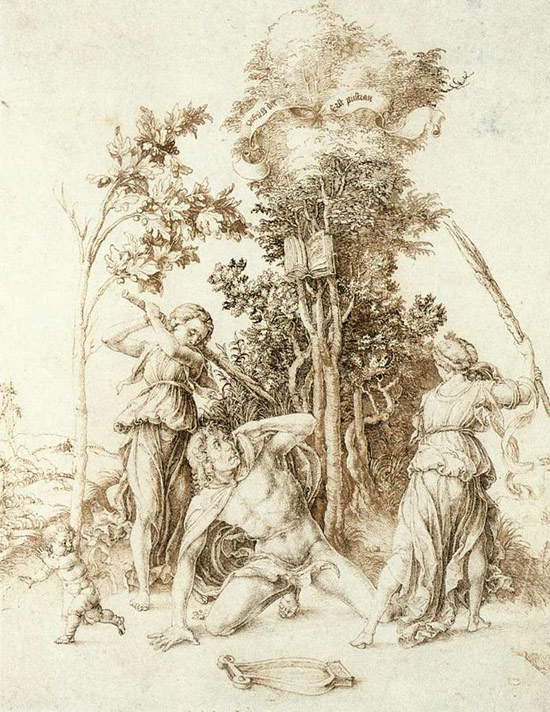 |
| Albrecht Dürer, Death of Orpheus (1494; pen drawing on paper, 28.9 x 22.5 cm; Hamburg, Kunsthalle) |
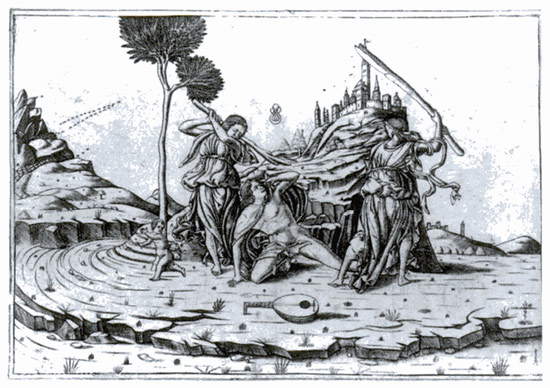 |
| Ferrara Master, Death of Orpheus (c. 1460-1470; engraving; Hamburg, Kunsthalle) |
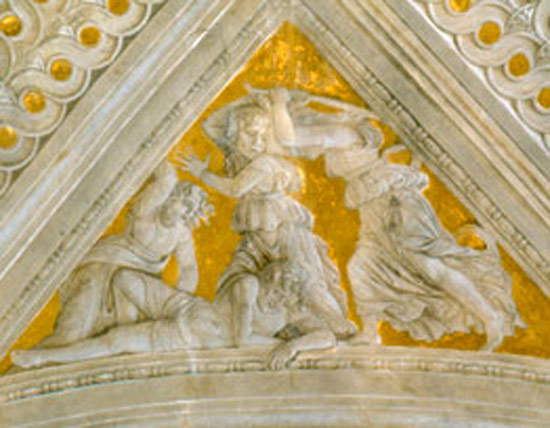 |
| The Death of Orpheus in the Bridal Chamber of Andrea Mantegna |
Panofsky’s critique of Wölfflin stems, in the words of aesthetics scholar Maddalena Mazzocut-Mis, from the need “to find in iconological interpretation the tool for arriving at the intrinsic meaning of the subject of the work, which is the revealer of an underlying attitude of a people, of a historical period.” Panofsky’s analysis cannot disregard the analysis of the content, indeed: it is precisely the content that becomes the main object of the German scholar’s investigation. It is within this context that the discipline oficonology proper is born, which Panofsky defines in these terms: “iconology is that branch of art history which deals with the subject or meaning of works of art as opposed to their formal values.” The aim of analyzing the subject or meaning of a work of art is to probe the relationships that a society establishes between form and content, in light of the fact that a work is “a symptom of something else that expresses itself in infinite other symptoms,” to borrow the words Panofsky uses in the introduction to his Studies in Iconology, a collection of essays originally published in 1939 (and released in Italy under the title “Studies in Iconology” for Einaudi, in several editions). That introduction is essential reading for anyone who wants to approach an understanding of iconology. It is therefore worthwhile to see what the foundations of the discipline are according to Panofsky.
Indeed, it is in Studies in Icon ology that Panofsky outlines the foundations of iconology. Starting with the different meanings that a work can take on. Exactly like the act of taking off one’s hat (this is the example proposed by Panofsky himself: the moment I identify as a greeting the object of my vision, a friend, and the event I witness, the act of taking off my hat, I already move from the sphere of perception to that of meaning, and on the basis of that meaning I will behave accordingly) is simply a physical event that, however, as a result of the interpretation provided by our psyche, is charged with a meaning that takes into account a history and a precise cultural substratum (Panofsky traces the act of taking off one’s hat to the Middle Ages, when knights would remove the helmet of their armor to show good intentions and accord trust to their neighbor) revealed by the personality of the person making the gesture, in the same way the work of art is given by a set of elements that take on meaning and reveal historical and cultural aspects of the society to which the artist belongs. With this in mind, for Panofsky the analysis of a work of art can be conducted on three levels. The first is pre-iconographic description, which deals with the primary or natural subject, that is, the pure forms representing human figures, animals, objects and so on. The primary subject in turn can be subdivided into factual subject (a man or woman) and expressive subject (a pose that conveys sorrow or cheerfulness, or, in relation to objects, the serenity of a setting, for example). The second level is that of iconographic description, aimed at establishing the secondary or conventional subject. It is worth pointing out that iconology and iconography are two distinct terms, endowed with different meanings: to offer a very basic explanation of this difference, we can say that iconography is the discipline that merely describes the subjects of images (thus iconography establishes what an image represents), while iconology interprets such subjects by explaining, for example, what motives have led a society to attribute symbolic meaning to the subject (iconology thus deals with the whys of the artistic motifs of an image). The second level of Panofsky’s analysis, then, aims to describe the conventional meaning of an artistic motif: for example, a man with a knife represents St. Bartholomew, a set of twelve people at a table around an additional figure is interpretable as a Last Supper, and so on. Finally, the third and last level is that of iconological description: the latter identifies the intrinsic meaning (or “content”) of the image, which is given by the ideas and attitudes (arising from philosophical or religious convictions, or from belonging to a historical period, a social class, or a geographical area) of the society to which the artist belongs and which condition him or her.
Panofsky, in order to provide an example, applies this kind of analysis to a work attributed to a seventeenth-century Venetian artist, Francesco Maffei, kept at the Pinacoteca Comunale di Faenza, which another art historian, Giuseppe Fiocco, had published as Salome with the Head of the Baptist. Incidentally, today the hypothesis is emerging that the work is instead to be ascribed to the hand of Bernardo Strozzi: however, for mere adherence to Panofsky’s text, I will continue to refer in this article to Francesco Maffei. At the preiconographic level, we distinguish a beautiful woman holding a sword and a basin with a man’s severed head, all in a wooded landscape. At the iconographic level, we could be faced with two options: on the one hand, we could identify the subject of the work with the one proposed by Fiocco, namely Salome with the head of the Baptist. However, there is a similar subject, in which a good-looking youth, a severed head and a sword equally appear: this is Judith with the head of Holofernes. A problem arises at this point: neither subject is perfectly consistent with the literary sources. In the Bible, in fact, Salome did not personally behead John the Baptist, but delivered the head to Herod on a tray (thus the subject would explain the basin, but not the sword), while Judith beheaded Holofernes with her sword, but hid the head in a sack (thus the sword would be explained, but the same could not be said of the basin). Therefore, relying solely on pre-iconographic and iconographic description, we would not be able to determine for what reasons Maffei depicted the subject in this way nor, of course, exactly what the subject is. The problem is therefore solved at the iconological level. In northern Italy, as well as in the Germanic area, earlier depictions had appeared with the type “Judith and Bacilus,” while there was no work in which Salome carries a sword: it was therefore from such a repertoire that Maffei had drawn. In order to understand the reasons why the plate motif had passed to Judith, it is necessary to refer precisely to the cultural and social substratum underlying the iconographic subject of “Judith with Bacilus” in Italy from the 14th century onward, a time to which Panofsky traced the cult towards the image of John the Baptist’s head on a tray: adevotional image that had become so popular that the bacile was substituted for the sack in scenes featuring Judith (in fact, artists more readily associated the decapitated head with the image of the tray because it was more familiar to them).
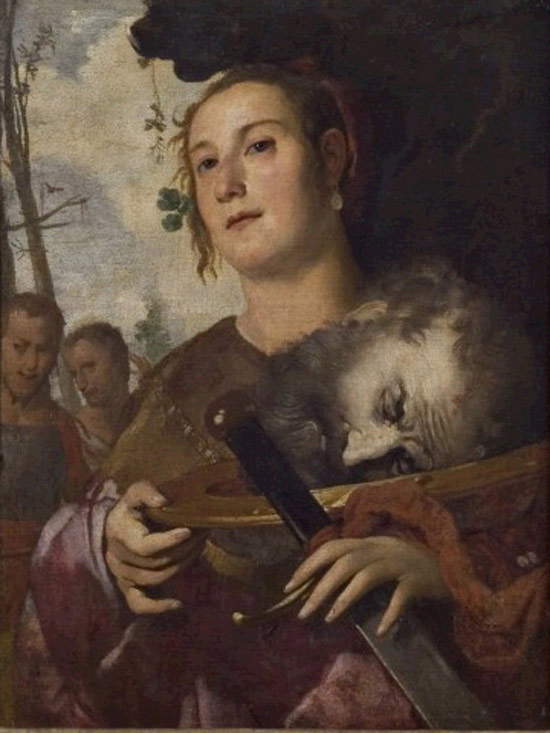 |
| Bernardo Strozzi (?), formerly attributed to Francesco Maffei, Judith with the Head of Holofernes (c. 1640; oil on canvas, 68 x 90 cm; Faenza, Pinacoteca Comunale) |
What Panofsky introduced was a kind of revolution in the reading of works of art, especially since it was enunciated in a systematic, clear, precise, practical way and with various examples. His method of analysis had a profound influence on generations of art historians, and his vast culture in addition to his great skill in being able to conduct impeccable historical analyses of the paintings he examined also contributed greatly to the spread of his studies. His role was also instrumental in boosting the environment of U.S. art history scholars. Panofsky had in fact moved to America to escape Nazism in 1933: he remained in the United States, where he conducted his scholarly and teaching activities, for the rest of his life. Of course, Panofsky’s method also encountered resistance, beginning with that of Otto Pächt, according to whom the risk of the iconological method would consist in viewing the work of art exclusively as a product of reason: in particular, according to Pächt, iconology tends to see the work “not as the expression or form of an idea, but rather as its disguise,” meaning that the idea and the creative act behind the work would not be considered autonomous and independent, but merely tools for giving a visual form to a symbol (it must be said, however, that already in several passages found in some of the essays in Studies in Iconology, Panofsky had attributed considerable importance to the personality of the artist). Nevertheless, the fact remains that the iconological method developed by Erwin Panofsky is still one of the most valid methods through which to analyze a work of art.
Reference bibliography
Warning: the translation into English of the original Italian article was created using automatic tools. We undertake to review all articles, but we do not guarantee the total absence of inaccuracies in the translation due to the program. You can find the original by clicking on the ITA button. If you find any mistake,please contact us.